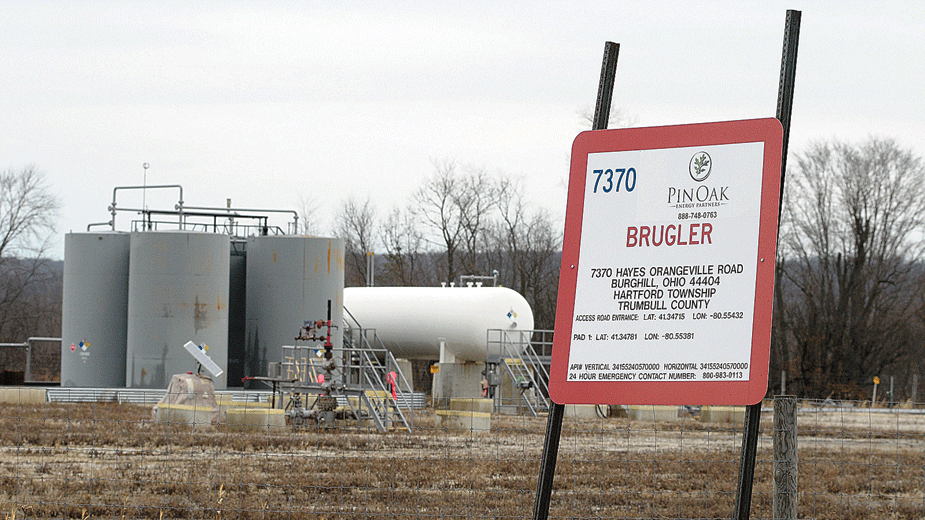Pin Oak Energy Pins Hope on Northern Utica
YOUNGSTOWN, Ohio — Where others have experienced nothing short of a bust, an Akron oil and gas company envisions nothing but opportunity.
Pin Oak Energy Partners LLC is jockeying for position in the northern tier of the Utica shale, especially in Trumbull County and parts of Mahoning County in Ohio, and Mercer County in Pennsylvania. In February, the company announced it has acquired more than 70,000 leasehold acres in the southern and northern Utica and a collection of active wells.
“We’re not buying acreage,” says Mark Van Tyne, Pin Oak chief business development officer. “We are buying cash-flowing assets. We’ve acquired assets that others didn’t feel were producing.”
Energy giants BP America and Halcon Resources Corp. moved into the region in 2012 during the early phase of Utica shale exploration. After almost two years, the payoff hoped for from the wells that both companies drilled, mostly in Trumbull and Mercer counties, simply was insufficient to justify continued oil and gas exploration in the northern Utica. So BP and Halcon canceled their drilling programs.
Van Tyne would not disclose the financial terms of the most recent deal, nor would he confirm whether it purchased assets from Halcon or BP. “We’re continuing to seek opportunities that make sense to us,” he says. “We’re not just buying unconventional [horizontal] wells, but conventional wells also.”
According to the Trumbull County recorder’s office, last summer Pin Oak entered into a lease assignment agreement with Halcon Resources Corp. and its subsidiaries for assets of the Houston-based company. That deal encompassed Halcon’s well equipment, gathering lines and producing horizontal wells, such as the Kibler 1H and 2-3H in Lordstown, the Brugler 1H in Hartford, and the Avalon Farms 1H in Vienna. The agreement also included former BP wells in Mecca and Hartford.
Pin Oak also entered into assignment agreements with Halcon that acquired assets in northwestern Mahoning County, which included its Grenamyer well in North Jackson and related pipeline infrastructure, according to the Mahoning County recorder’s office.
And in Mercer County, Pin Oak acquired Halcon’s Yoder 2H well and the Phillips 2H well along with its gathering and transmission lines, according to records.
Halcon entered Chapter 11 bankruptcy in July 2016 and restructured. It emerged from bankruptcy a month and a half later.
Van Tyne says Pin Oak is still in its early stages of development in this part of the Utica. Companies that entered the play in 2012 were the pioneers in the northern tier, he noted, but they found that the level of production didn’t fit their business plan. “The results did not meet their expectations,” he says, “so they chose to leave.”
That was four years ago. Advances in drilling technology and in geological sciences could lead to additional exploration and production in the northern Utica, he continues. Moreover, geologists are getting a better understanding of the play and how to improve oil and gas extraction from tighter rock formations. “These were more challenging areas than some of the simple, straightforward areas,” Van Tyne says, that energy companies leased in the southern tier of the Utica.
Natural gas production in the northern tier of the Utica has sputtered at best, especially when compared to the enormously successful wells other energy companies have drilled in places such as Belmont County in the southern portion of the play.
For example, one well owned by Ascent Resources in Belmont County yielded more than 2.1 billion cubic feet of natural gas over the 92 days of the third quarter of 2017, according to the Ohio Department of Natural Resources. Pin Oak’s Kibler well produced just 25.8 million cubic feet of gas during 60 days of the third quarter.
Still, drillers such as Houston-based Hilcorp Energy Co. have maintained a presence in the northern Utica, especially in Columbiana County and Mercer and Lawrence counties in western Pennsylvania. Hilcorp operates six producing wells in Columbiana County and another 30 are permitted there and it operates seven producing wells in Mahoning County.
Van Tyne says Pin Oak Energy plans to assess the positions it’s acquired, but at this time is not in the business of amassing acreage through new leaseholds. “A lot of geology has to be put in play,” he says. “We’ll fill in leasing, and possibly drill sometime in 2019 or 2020.”
The Utica continues to attract attention six years into the play because energy companies have discovered new methods to produce natural gas at a profit even in a low-priced commodities market, says Jeff Dick, chairman of the geology department at Youngstown State University.
“The downturn in 2014 forced these energy companies to become more efficient,” Dick says. New designs for hydraulic fracturing – dubbed “super fracks” – provide for longer well laterals and more sand and water injected into the well to stimulate production in the rock. This process has allowed these wells to boost production.
As such, shale drilling has become much less expensive in the Utica and nearby Marcellus shale in Pennsylvania, Dick says. Today, companies are using smaller rigs to drill the vertical portion of the well first and set the casings in place. The verticals are drilled one after the other on a single well pad. Once that derrick is moved out, another rig moves in and completes the horizontal legs.
It’s these laterals that are changing the way oil and gas is obtained from the Utica. When the first Utica laterals were drilled, it was common to find a horizontal leg somewhere between 5,000 and 6,000 feet long. “Today, it’s not uncommon to drill some that are 18,000 feet,” Dick says.
Most of the leasehold arrangements across the Utica are locked up, he adds, and all that remains is developing the acreage. It’s likely the number of permits will stabilize and companies might not drill as many because the newer wells are likely to extend longer and draw more gas and oil.
Andrew Thomas, director of the Energy Policy Center at Cleveland State University, agrees that new exploration and completion techniques make the Utica a very desirable region to drill. “They’re not slowing down production,” he says.
Energy companies across the play have figured out some of the Utica’s quirks and are using these methods to maximize production at each well, Thomas says. Moreover, companies have dramatically reduced the time and cost it takes to drill a well versus what it cost when the Utica first opened up.
When the first Utica wells were placed into production around 2011, energy companies opened the throttles on newly drilled wells to impress investors on production levels and the Utica’s potential, Thomas says. In doing so, some of the wells exhausted their reservoirs, drastically reducing production the following year. Now, these companies have found how to better manage oil and gas reservoirs in the Utica, improving the ultimate return on each well.
“They’ve learned through trial and error,” Thomas says.
These efficiencies, matched with additional insight into the Utica formation, could help unlock reserves in untapped areas such as the dry and wet gas windows in the north and the condensate and oil windows to the west, Thomas says.
And, the industry is considering other stimulation methods such as “refracking” – where an existing well is hydraulically fractured a second time to recover additional oil and gas in the shale. “Some of these wells are six or seven years old, and when they were drilled, they might not have used the best technology,” he says.
Thomas has seen projections that refracking an existing well could lead to recovering as much as 80% of that well’s initial production, only at one-third of the cost of developing a new well.
“There are huge parts of the Utica that remain undeveloped,” he says. “I think there’ll be a lot more drilling to come. There’s plenty to do in the Utica.”
RELATED:
In 2 Years, Pin Oak Becomes Major Player
Pictured at top: This well in Hartford Township was drilled five years ago by Halcon Resources, which filed Chapter 11 in 2016.
Copyright 2024 The Business Journal, Youngstown, Ohio.


